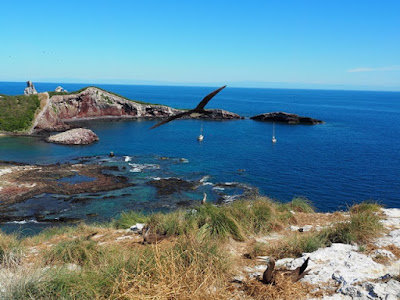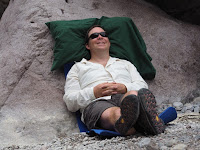Ten days ago we did a 3-day, 320 nm passage from La Paz to a
tiny island off the coast of mainland Mexico called Isla Isabel. Unlike our first passage across the Sea, this
one was almost pleasant. Almost. We thought we’d picked the perfect weather
window. The “Fast Sea” weather/passage
planning software we were using predicted we’d have no more than 16 knots of
wind from the NW and small seas for the entire crossing. That was once the cold front that was
travelling down the Sea of Cortez had passed, which it was supposed to do the morning
we left…BEFORE we left.
The first 12 hours of the passage were pleasant. We did indeed have 15 knots of wind and had a
beautiful sail down the Cerralvo channel.
Just after nightfall, after we’d left the safety of the Baja coastline,
we looked behind us and saw a sight guaranteed to strike fear into the heart of
any offshore sailor. Lightening. And LOTS of it! Unfortunately I had just put lasagna in the
oven for dinner and so we weren’t able to put our spare GPS and radio in oven
(our faraday container on board) to protect them in the event of a lightening
strike…
With no choice but to carry on, we reefed the main and
watched the squalls form all around us.
At one point we were in the centre of 5 different squalls, with
lightening hitting the water all around us.
It was nothing short of terrifying.
By midnight the thunderheads had moved off to the east, but the wind
climbed to 30 knots and stayed there for the duration of the night. We sailed with just a double reefed main and
made amazing progress. So much for the
“Fast Seas” prediction. By morning we
were 12 hours ahead of where we were supposed to be by their calculations!
 |
| Male frigate bird on Isla Isabel |
Days two and three were much tamer. The seas were still big, but the winds were a
gentle 10-15 knots. Unfortunately we
ended up travelling too quickly and our arrival time to Isla Isabel showed after
dark. We slowed the boat way down and
sailed at 1.5 knots for the last 15 miles so that we pulled into the island at
first light.
Isla Isabel was spectacular.
The first thing that hit us was how green it was! I don’t know why that surprised us so much,
but after sailing in the Mexican desert for the last 2 years, you get used to
seeing brown, not green. The second
thing that struck us was the birds.
There were literally thousands of frigate birds and boobies circling
over the island. Talk about wild.
 |
| Isla Isabel, south anchorage. Boobies and frigates fore and aft. |
The island has 2 anchorages, one on the south side, and one
on the east. Neither is tenable in
anything other than calm seas. The seas
were definitely calming down when we arrived, but the breakers rolling across
the south anchorage and crashing into the rocks were humbling, to be sure. We anchored in the south bay. As the anchorage is known to have a rocky
bottom that has “eaten more anchors than anywhere else in Mexico”, we attached
a trip line and Gary got in the water and manuevered the anchor into a favourable
sandy spot (there is only one – the joy of being the first boat to arrive!).
Despite only getting snatches of sleep for the last 3 days,
we put the dinghy in the water and went to explore. The island is called the Mexican Galapagos as
the inhabitants have no predators and so aren’t afraid of people. As a result, you can get up close and
personal with frigates, iguanas and nesting boobies. It was incredible.
 |
| Gary and the Iguanas |
 |
| Boobie on its nest |
 |
| Building a nest, Booby style! |
The
highlight was watching a pair building a nest.
The male would gather grass then prance over to the nest and place it
around the female. They’d then click
bills and cackle at each other. It was
adorable. I got the most amazing video.
The island itself is a national park and was home to an
impressive looking research station which was built in 1980, but like so many
buildings in Mexico, has fallen into disrepair.
Supposedly researchers still go there and camp in the abandoned
building, but no one was present when we were visiting.
 |
| Fish camp, with thousands of frigate birds hovering above |
The island is also home to a well-run fish
camp. The Mexican government must have
built the huts on the beach at the same time as the research centre, as they
are identical and are painted green to blend into the background. It is a very active camp, which houses the
long-line fisherman. The fisherman go
out and set lines with thousands of hooks on the surface, marked with pop
bottles, that go for miles. Each end is
marked by a pole with a black flag. We
regularly saw the fishermen going out with nets full of pop bottles and reels
of line wrapped around the poles. While
we were impressed at how hard these men worked, we were saddened by their
impact on the ocean. These longlines are
extremely hazardous to by-catch (dolphins, turtles, whales), not to mention
sailboats trying to traverse the area! We caught one on our passage from Isla Isabel
to the mainland, but luckily it came off with a bit of coaxing. As you traverse this area of the coast in a
sailboat you can’t help but feel like the ocean has been booby-trapped. But, I understand people have to eat and it
isn’t a simple problem and doesn’t have a simple solution. Like so many things in life.
After spending two lovely days soaking up the atmosphere on
the island, the wind and waves picked up and it was time to go. We had a pleasant overnight sail to La Cruz,
in Banderas Bay (Puerto Vallarta) and spent a few days catching up with friends
and enjoying the Cruiser activities (Movie Night, Cruiser Welcome Party
etc).
 |
| Impromptu Blue Water Cruising BURP (unplanned rendezvous) in La Cruz |
Here are a few more pictures of the inhabitants of Isla Isabel:
 |
| Frigate doing god knows what |
 |
| Posing for the camera |
 |
| Juvenile male frigate developing his red throat sac (sign of maturity) |









































